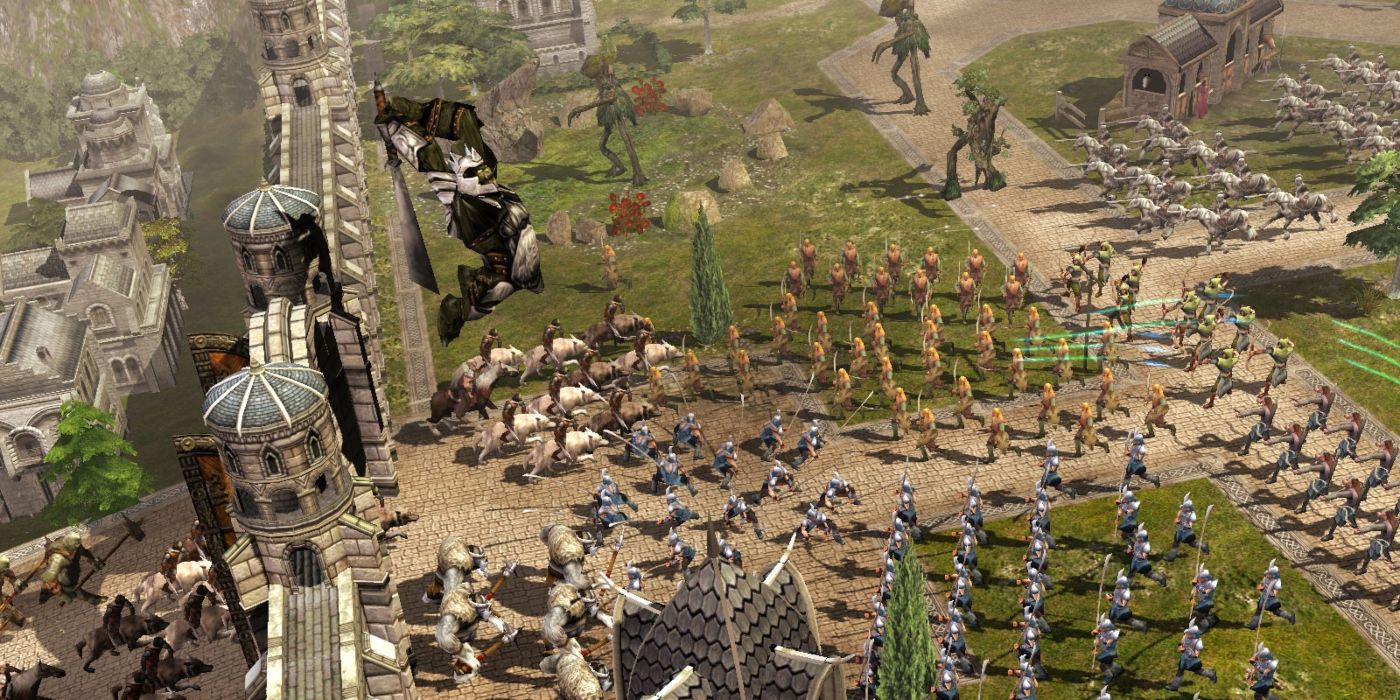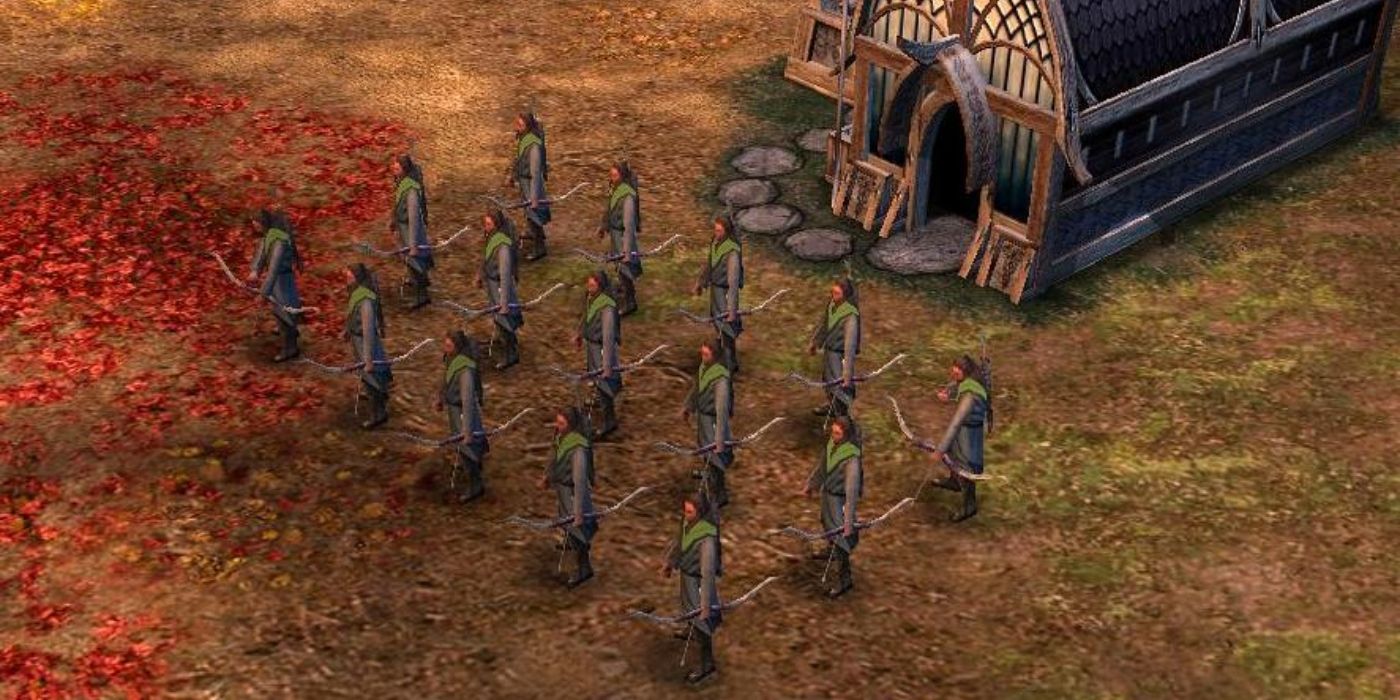The Elves are arguably the strongest defensive faction in Electronic Arts’ Lord of the Rings Battle for Middle-Earth II: The Rise of the Witch-King. With their famously accurate archers and a diverse assortment of Elven heroes to choose from, they can suddenly mount a planned offensive both swiftly and stealthily. The key to the Elven strategy is choosing when it’s time to regroup and heal and when it’s time to push.
As with any faction, it’s critical that the Elves can field a large enough army that their push is significant. This is accomplished by increasing command points, a function of resource structures. Building and managing a large, powerful army is crucial in all the best real-time strategy games, and BFME 2 is no exception. In addition to maxing out the command point pool, resource structures also provide a secondary function: passively generating resources. Space is required to maximize this, but spreading too thin and too far from where they can be adequately defended will eradicate them.
Mallorn Trees are the resource structures for the Elves, and they are priority targets for the enemy AI, which can destroy them quickly. As such, the best approach with the Elves is somewhat counter-intuitive. Rather than aim for a quick victory and map control like with the more aggressive factions, the Elves benefit from keeping close to their fortress and playing to their strengths: Leaning on the superior range and damage of their Mirkwood Archers.
The Elves Faction In BFME 2: The Rise Of The Witch-King
Early survival defines a medieval RTS game. The right build order can mean everything. The best way to start a match with the Elves is to build an Elven Barracks and a Mallorn Tree quickly. Once the barracks are complete, begin recruiting a couple of Lorien Archers and Mithlond Sentries. While one builder begins making Mallorn Trees (ideally close to the fortress and blocked by the barracks), the other builder should make a Heroic Statue followed by a Mirror of Galadriel. Keep the archers positioned near the statue to maximize their damage, and use the sentries to defend them from cavalry. This is especially important against the Men of the West as Gondor and Rohan boast formidable horsemen.
From this point, the strategy is primarily determined by the amount of starting resources selected. It’s encouraged for most factions to start with as many as possible. For lower numbers, focus on Mallorn Trees and Battle Towers (which increase the already impressive range of Elven archers). If starting with higher limits of command points, now is a good time to tack on a famous Lord of the Rings character.
Elrond is expensive, but he is usually the best choice since he has the most powerful late-game abilities. Acquiring him this early in the match will grant him the levels required to unlock his most useful spells. In addition, his Far Sight ability should be used as often as possible to better plan for the inevitable AI rush. If the AI is building cavalry, produce more sentries. If they’re making pikemen, start adding Lorien Warriors to the mix to counter them.
The Elves also have the advantage of speed and stealth. With the reconnaissance provided by Far Sight (both the faction power and Elrond’s ability), they can plan ambushes in any wooded area, camouflaging with the trees to unleash a volley of arrows from multiple directions. Elrond’s tornado is almost as powerful as Gandalf’s crowd-clearing abilities in LOTR BFME 2 and should not be underestimated. Elves can also outrun most factions (not the Uruk hai), encouraging almost guerrilla warfare. This forward strategy works incredibly effectively when coupled with Heroic Statues or heroes who provide leadership, such as Elrond or Haldir.
The last part of the Elven strategy comes from their unique siege units: Ents. Slow-moving and vulnerable to fire, Ents are still more durable than the catapults and ballista of most factions. Ent Sentries can also be built to directly guard the fortress. This should be done as early as possible, but since they’re expensive, they should be built where they can most effectively guard the nearest surrounding Mallorn Trees. Around mid-game, an Ent Moot is required for producing mobile Ents. Their advantage is that they can be set to melee mode when defending themselves in close quarters. They will then brawl with infantry like Gundabad warriors or goblin swarms. Having 2-3 accompanying your fortress defense is a reliable way to support the archers and sentries.
Far Sight is a valuable component in deciding when to move from defense to aggression. It will show when the enemy is pouring forth, leaving their base unprotected. With their superior speed, the Elves should be able to seize the moment and intercept and flank the enemy camp from an unexpected angle. Protect the Ents with Lorien Warriors and heroes, using powers to buff. By now, the fortress should be strong enough to defend itself on its own, at least long enough for the Elves to cripple the enemy forces with one strong, decisive attack.
The Lord of the Rings Battle for Middle-Earth II: The Rise of the Witch-King is available on PC, PlayStation 4, Xbox One, PlayStation 5, Xbox Series X/S, and Nintendo Switch.


